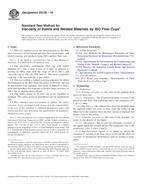We need your consent to use the individual data so that you can see information about your interests, among other things. Click "OK" to give your consent.
ASTM D5125-10
Standard Test Method for Viscosity of Paints and Related Materials by ISO Flow Cups
STANDARD published on 1.7.2010
The information about the standard:
Designation standards: ASTM D5125-10
Note: WITHDRAWN
Publication date standards: 1.7.2010
SKU: NS-29926
The number of pages: 8
Approximate weight : 24 g (0.05 lbs)
Country: American technical standard
Category: Technical standards ASTM
Annotation of standard text ASTM D5125-10 :
Keywords:
efflux cups, flow cups, ISO cups, viscosity, Automotive coatings/paints, Efflux cups, Flow and flow rate--paints/related coatings/materials, Flow cup(s), Industrial coatings/applications, ISO (International Standards Organization), Viscosity--paints/related coatings/materials, ICS Number Code 87.040 (Paints and varnishes)
Additional information
| Significance and Use | ||||||||||
|
This test method is useful for the determination of package and application viscosities of paints and other coatings. It is limited to Newtonian or near-Newtonian liquids. This test method may be used similarly to ISO 2431 in conjunction with flashpoint to determine the hazard grouping of viscous liquids in international regulations. |
||||||||||
| 1. Scope | ||||||||||
|
1.1 This test method covers the determination of the flow time (viscosity) of Newtonian and near-Newtonian paints, and related coatings and products using ISO capillary flow cups. Note 1—If the liquid is non-Newtonian, that is shear-thinning or thixotropic, Test Methods D2196 should be used. 1.2 The cup-orifice combination (ISO cup with orifice diameter of 3 mm, 4 mm, 5 mm, or 6 mm) is selected to provide an efflux time with the range of 20 to 100 s and viscosities up to 700 cSt (700 mm2/s). The most commonly used cup is the one with the 4-mm orifice. 1.3 This test method is limited to testing materials for which the breakpoint of the flow from the orifice of the flow cup can be determined with certainty. This point is difficult to determine and reproduce for materials with flow times in excess of 100 s due to slowing-down effects. 1.4 The values stated in SI units are to be regarded as standard. The values given in parentheses are for information only. 1.5 This standard does not purport to address the safety concerns, if any, associated with its use. It is the responsibility of the user of this standard to establish appropriate safety and health practices and determine the applicability of regulatory limitations prior to use. Note 2—The International Civil Aviation Organization (ICAO) and the International Maritime Organization (IMO) include in their regulations a similar test (ISO 2431) to determine the viscosity of hazardous viscous liquids. The viscosity is then used to place these liquids in a hazard packaging group depending on their viscosity/flashpoint relationship. The U. S. Department of Transportation permits the use of these regulations for transhipment of hazardous material within the U.S. when bound for foreign destinations. |
||||||||||
| 2. Referenced Documents | ||||||||||
|
We recommend:
Technical standards updating
Do you want to make sure you use only the valid technical standards?
We can offer you a solution which will provide you a monthly overview concerning the updating of standards which you use.
Would you like to know more? Look at this page.




 Cookies
Cookies
